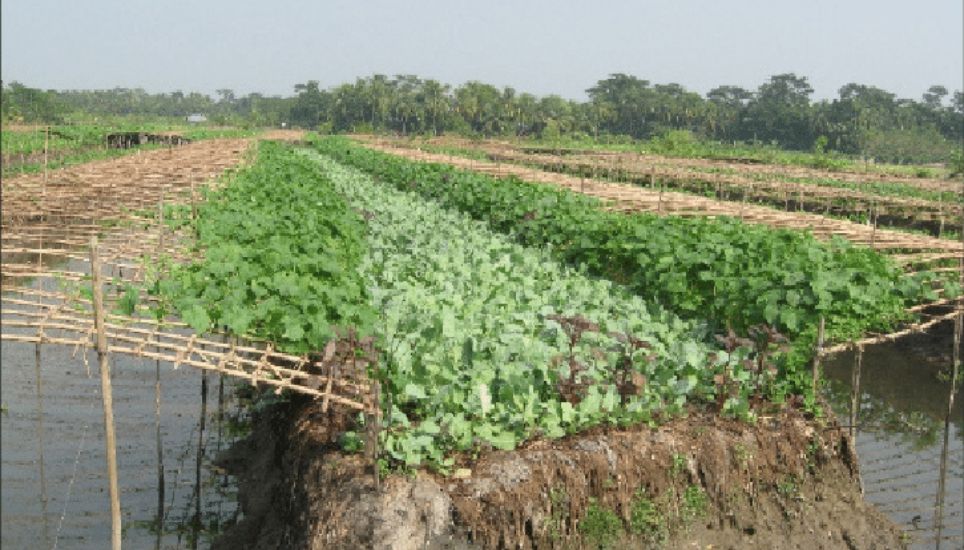
Rain is grace; rain is the sky descending to the earth; without rain, there would be no life, is a perfectly said quotation by John Updike. But heavy monsoon could be a curse for the low lying parts or southern part of our country Bangladesh, as these areas get waterlogged for months.
Recently, climate change has made the situation worse, different areas face the water logging problem for nine to ten months! As a result Water quality, biodiversity, fisheries, agriculture, human health and most important fact, food security of those areas got hampered.
Malnutrition has become a notable issue
Remaining high lands are used as paddy fields but most of the low lying areas got waterlogged.
For a poor and developing country like Bangladesh, it is very important to find cheaper and sustainable solutions that could easily be widely implemented by the farming community and solve the malnutrition problem.

Agriculturists are developing different methods to grow foods in low land with sustainable and local products.
Agro tech and their working methods in areas covered by water
Bangladeshi people have been practicing hydroponics using floating gardens for over 400 years. They are known as "Baira, Geto, Bed, Dhap," or bhashoman chash.
A floating garden is built from water hyacinths or other aquatic weeds that are collected to build a floating raft. Organic materials such as paddy stalks, straw and coconut shells are also added.
It is covered with soil and cow dung where vegetables and fruits can be planted. Crops planted in these beds avoid watering and benefit from nutrient-rich decomposing matter, reducing the need for chemical fertilizer.
Farmers grow about 300 different vegetables, Navigating waterways by boat.
Another method is known as the "Sorjan" method. To cultivate using this method, one first builds clay banks around the land, from the center of which mud is taken, which is used as a pond, so farmers can harvest fish and vegetables together.
The "Bosta or Dali" method has been widely adopted after the shutdown of COVID-19 due to economic recovery. These are basically small nylon baskets that carry hyacinths or other aquatic plants and soil, supported by a bamboo box over a body of water.
In the meantime, you can also do different fish breeding methods.
Floating agriculture: Sustainable and cheap?
All the methods described above contain almost the same and sustainable ingredients such as bamboo, water hyacinth or various aquatic plants, etc., which can be produced and found locally. This cultivation method does not require chemical or extensive fertilisers.

Every year you have to build a new raft or dali (basket), but the old one can be used as fertiliser in dry times. Since rafts can be moved from one place to another, they are also suitable for those who have lost their homes temporarily or permanently.
A sustainable way to address malnutrition
Floating gardens increase food security by consuming nutrients through growing vegetables. Areas of land that cannot be cultivated become usable and the income generated ensures food security and versatility during the floating garden season.
The gardens are home to an amazing variety of crops including beans, beetroot, pumpkin, okra, eggplant, cucumber, red amaranth, pumpkin, turnip, cauliflower, turmeric and chili.
The Sorjan or dali method has an excellent combination of cultivation of both vegetables and various fish such as tilapia, carp, silver carp, pangash, which can satisfy the nutritional needs of the place.
It helps to maintain a balanced diet with carbohydrates, proteins and other nutrients. Household food security is restored for men and women.
Impact of floating farming on livelihoods
Floating vegetable farming in Bangladesh is already globally recognized as a traditional farming method. It is difficult for poor families or catchment areas to manage the available farmland.
As an alternative, floating gardening is a sustainable farming method and income strategy for rural households, their income level increased 4-5 times from the income of the traditional farming method.
Both men and women have to work hours in the different process of the method, so the women of our country are becoming self-dependent day by day. It ensured both public health and the economic stability of countries in severe conditions.
Probable challenges in implementing this tech
Adapting something new and leaving the traditional method behind is difficult. Due to some unfavorable conditions of the socio-economic situation, this cultivation did not become a proper priority for the farmers.

On a large scale, farmers have problems such as lack of water hyacinth for beds, hyacinth causes itching and redness of the skin; the complexity of making a bed; and the biting of leeches during intercultural activities affected prominent farmers in this prospective agriculture.
Giving them the proper training is another challenge. A market is needed to make such a product profitable.
Despite having some challenges these methods are easily adaptable and meet dietary needs. This reduces the level of malnutrition and positively affects the socio-economic life of affected people.
The author of this article, Anushua Bhattacharjee, is a member of the Faculty of Agricultural Engineering and Technology at the Department of Food Engineering in Bangladesh Agricultural University, Mymensingh.